Attacus atlas(L.)
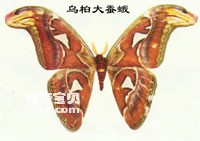
Wingspan 180-210 mm. The top angle of the forewings is significantly protruding, the body wings are auburn, and the inner and outer lines of the front and rear wings are white; the inner and outer lines of the inner and outer lines have purple-red borders and tan lines, mixed with pink and white scales in the middle; the middle chamber end There are large triangular transparent spots on the bottom; the outer edge is yellowish brown with thin black wavy lines; the top corner is pink, there is a half-moon-shaped black spot near the front edge on the inner side, and the lower part is khaki with purple-red vertical stripes and black spots. There are jagged white lines connected to the purple strips. The inner side of the hind wings is brown-black, the outer edge is yellow-brown with a black corrugated end line, the inner side has yellow-brown spots, and there is a russet spot in the middle.
Two generations occur every year in Jiangxi and Fujian. Adults emerge between April and May and July and August. They spend the winter as pupae in cocoons attached to the host. Adults lay eggs on the trunk, branches or leaves, sometimes in piles and arranged in rows. rule.
Host: Chinese tallow tree, camphor, willow, large-leaf Albizia julibrissin, small tiller, sweet potato, setaria, apple, holly, birch.
Distribution: Jiangxi, Fujian, Guangdong, Guangxi, Hunan, Taiwan; India, Myanmar, Indonesia.
Actias dubernardi Oberthur
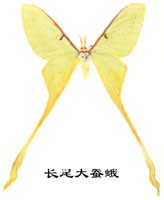
The wingspan is 90 to 110 mm. The body is white, the antennae are yellow-brown, the front edge of the chest is purple-red, and the rear edge of the shoulder plate is light yellow; the forewings are pink-green, and the outer edge is yellow; there is an eye stripe in the middle chamber, the center is pink, and there is a wider wavy black stripe on the inner side. There are white scales interspersed with them, and the outside is yellow with a tan outline; the outer line is not obvious. The tail process of the rear corner of the hind wing is extended into a ribbon shape, up to 85 mm long; the tail process is orange-red, the proximal end is yellow-green, the outer edge is yellow, the eye stripe in the middle chamber is pink, not very obvious, and the outer line is not obvious. There are two generations a year. The adults emerge between April and July and spend the winter as pupae in cocoons attached to branches.
Distribution: Guizhou, Fujian, Southwest.
Nyctalemon patroclus L.
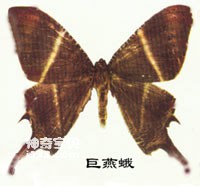
The wingspan is about 110 mm. The body wings are khaki, with white stains in the middle of the forewings, which are relatively straight. There are black and white knots on the front edge, brown scattered stripes between the middle band and the wing base, the outside of the middle band is light tan, and the outer edge is lighter in color. The middle band of the hind wings is not as obvious as the middle band of the forewings; the wing base is mostly downy, with brown wavy scattered stripes on the outer edge. There are 5 tooth-shaped processes and 1 tail band on the outer edge, with white in between brown.
Distribution: South China.
Brahmophthalma wallichii(Gray)
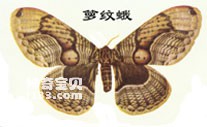
Wingspan 154 mm. The body color is yellow-brown, similar to the green ball basket moth, but it is extra large and has a yellower body color. The upper outer edge of the middle band of the forewing is not a concave arc but a protruding tooth; the end of the forewing is not a gray spot but an orange spot, and there are many "herringbone" patterns on three of the wing veins. The midline of the hind wings has a larger curvature, and the base of the wings is slightly yellow; there are only three hemispherical spots under the outer edge of the hind wings, and the rest are curved. The back of the chest and abdomen are black with yellowish-brown edges, and the dorsal midline of the abdomen is prominent. The pronotum of the larvae is yellow with black vertical stripes. There are upright horn processes on the 10th and 11th segments of the juvenile stage. The thorax and feet are reddish-brown with shiny black channels.
Distribution: Yunnan (Kunming), Sichuan, Hubei (Changyang), Taiwan; India.
Langia zenzeroides szechuana Chu et Wang
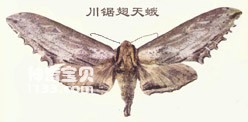
The wingspan is about 160 mm. The body and wings are blue-gray; the chest and back are yellowish-brown; the abdomen is gray, covered with long white scales at the ends, with three gray longitudinal bands at the proximal end and black spots below the longitudinal bands. The transverse lines of the forewings are not obvious. There are oblique white bands from the wing base to the top corner, and purple-black fine spots are scattered there. There are three continuous purple-black diagonal stripes from the top corner to the center of the trailing edge; the outer edge is serrated; the cilia are Grayish brown, the outer edge is wavy purple-black; there is a triangular purple-black spot at the end of the middle chamber. The hind wings are brownish gray, with white and purple-black stripes near the rear corner. The outer edge is black and purple, the fringes are yellow, and the ends are gray-black. The undersides of the front and rear wings are orange-grey with purple scattered spots. One generation occurs a year, and adults appear in early May.
Host: Plum, apricot, plum, peach, cherry and other Rosaceae plants.
Distribution: Sichuan (Qingcheng Mountain, Guan County).
Pseudojana incandesceus Walker
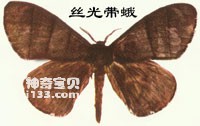
Wingspan is 126-141 mm for females and 101-118 mm for males. The body wings are reddish brown to russet, the antennae are grayish yellow to grayish brown, the head and front chest are reddish brown, the middle and back chest are brown, and the feet and abdomen are brownish red with a hint of orange. The body wings are covered with long scales, and the scales on the chest are dense and long. There are two horizontal lines on the forewing from the middle of the front edge to the rear edge. The inner side of the outer horizontal line is lined with tan colored stripes. The lower part of the broad band formed between the two lines is slightly narrower, and there are yellowish-brown and brown markings on the outer edge. The front half of the hind wings is slightly lighter in color, slightly yellowish brown; both front and rear wings have a silky luster, with the forewings being the most obvious. Adults appear in June.
Distribution: Fujian, Guangdong, Yunnan
Scopelodes venosa kwangtungensis Hering
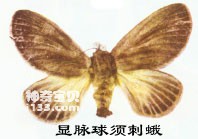
Alias: Guangdong tung black thorn moth.
The warp spread is 46-65 mm. The lower lip must be long, extending upward over the top of the head, and the tufts at the ends are entirely white. The head, chest and back are dark brown; the belly and back are orange-yellow, and there is a dark brown horizontal band on each segment starting from the third segment in the center of the back, and the distal segment is dark brown. The forewings are dark brown to black brown (the female moth is lighter in color), covered with silver-gray scales. The base of the fringe is brown and the ends are light yellow. The base 1/3 of the hind wing and the trailing edge are yellow, the rest is dark brown, the outer half of the wing veins are light yellow, and the fringes are the same as those of the forewings. The larvae of this species are yellow on the ventral side and green on the back, with two rows of dense spines. There is a red, white and blue horizontal stripe on the back of the 8th segment, and the hip segment has black spots.
Host: dates, persimmons, coffee and roses, etc.
Distribution: Jiangxi, Fujian, Guangdong, Sichuan, Yunnan, Zhejiang, Taiwan; Myanmar, Sikkim, Nepal, India, Sri Lanka, Indonesia.
Cerace xanthocosma Diakonoff
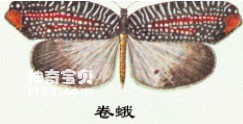
Wingspan is 33-40 mm in males and 48-59 mm in females. The head is white, and the hairs between the antennae are black; the lower lip is short, and the bottom and top of segments 1-2 are white; the chest is black and purple with white spots, there is an oblique white spot on the wing base, and there are a bunch of yellow-gray long hairs on both sides of the hindthorax. Clusters; half of the back of each abdominal segment is yellow, half is black, and the ventral surface is light yellow. The forewings are purple-black, filled with many white spots and short stripes. There is a rusty reddish-brown spot in the middle that leads from the base to the outer edge, and expands into a triangular orange area near the outer edge. The hind wings are broad, semi-oval, orange, and densely covered with round black spots of different sizes from the inner edge to 1/2 of the outer edge of the hip area.
Host: maple, gray wood, camellia, camphor, etc.
Distribution: East China, Southwest China; Japan and other places.
Phyllodes consobrina Westwood
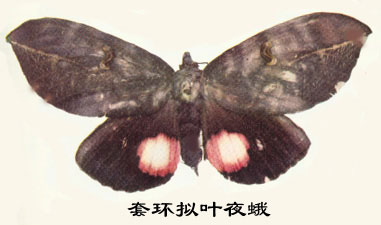
Body length 45-47 mm; wingspan 127-131 mm. The head and chest are dark brown, the head and neck plates are purplish gray, and the base of the tibia has yellow and white spots; the abdomen is dark brown with blue flashes on the back. The forewings are dark brown, with a moldy brown tone, scattered with yellow and white spots; the ring pattern is 1 black spot; the kidney stripe is large, brown, protruding in the rear, and there is a black-brown stripe in the center; 1 outside the lower corner of the middle chamber and 1 outside the rear corner of the kidney stripe There are white stripes, a moldy brown diagonal line from the wing tip to the base of the 3rd vein, and a wavy line from the middle of the 5th vein to the hip angle. The hind wings are dark brown with blue flashes, and there is a large red spot near the hip corner with a white center. The female moth's forewings are all the same color.
Distribution: Guangdong, Yunnan; Sikkim, India.
animal tags:
We created this article in conjunction with AI technology, then made sure it was fact-checked and edited by a Animals Top editor.